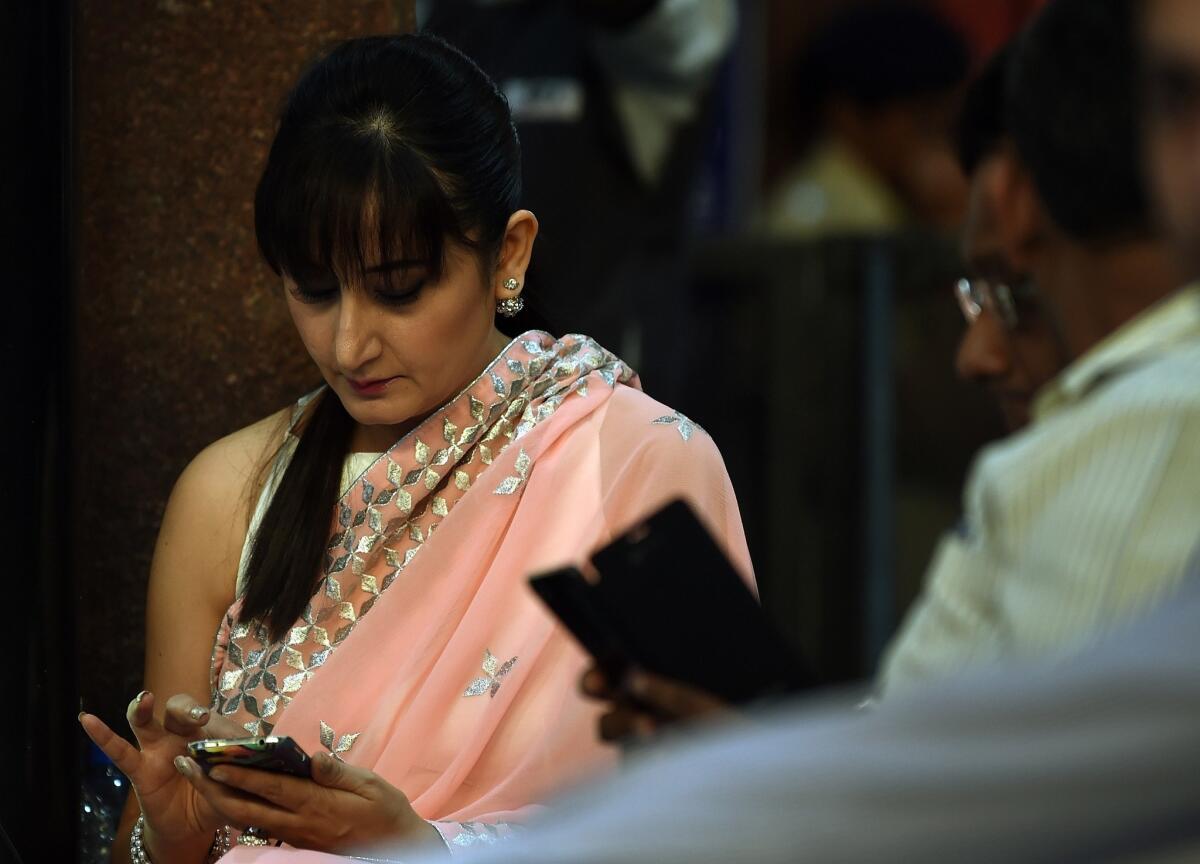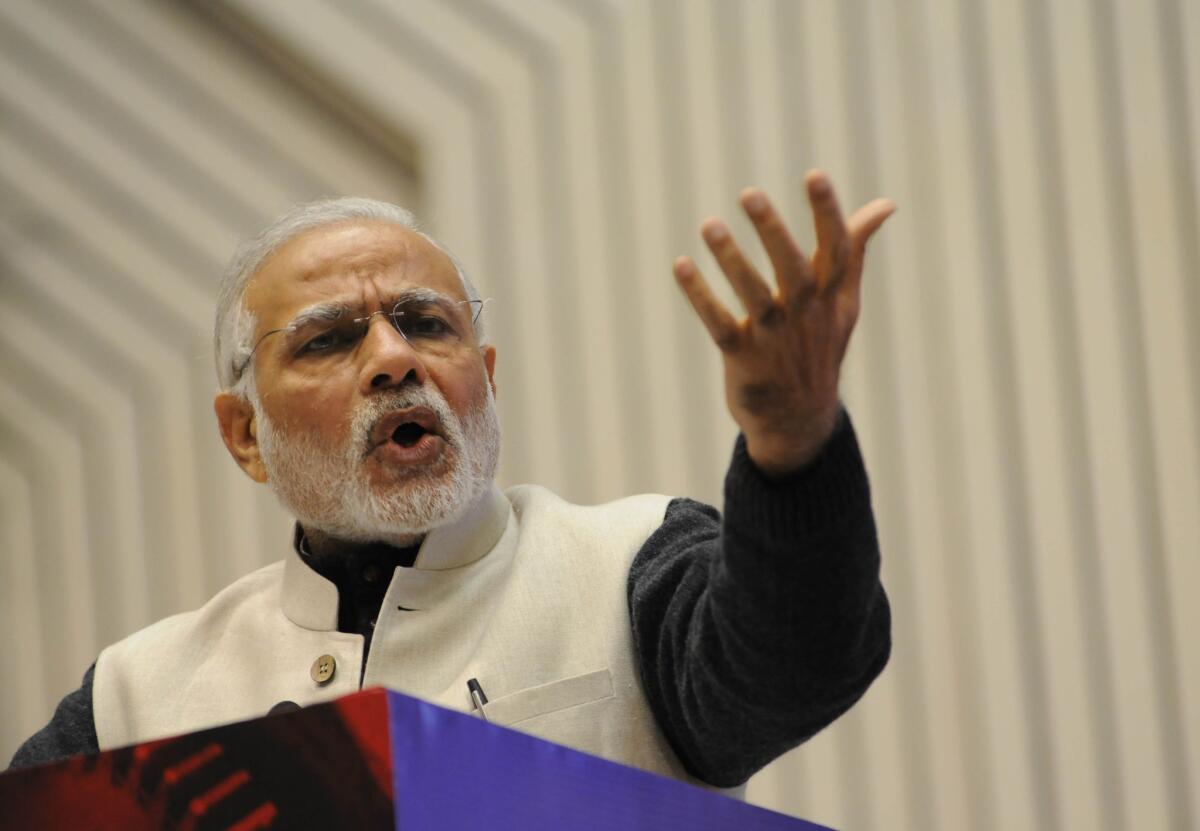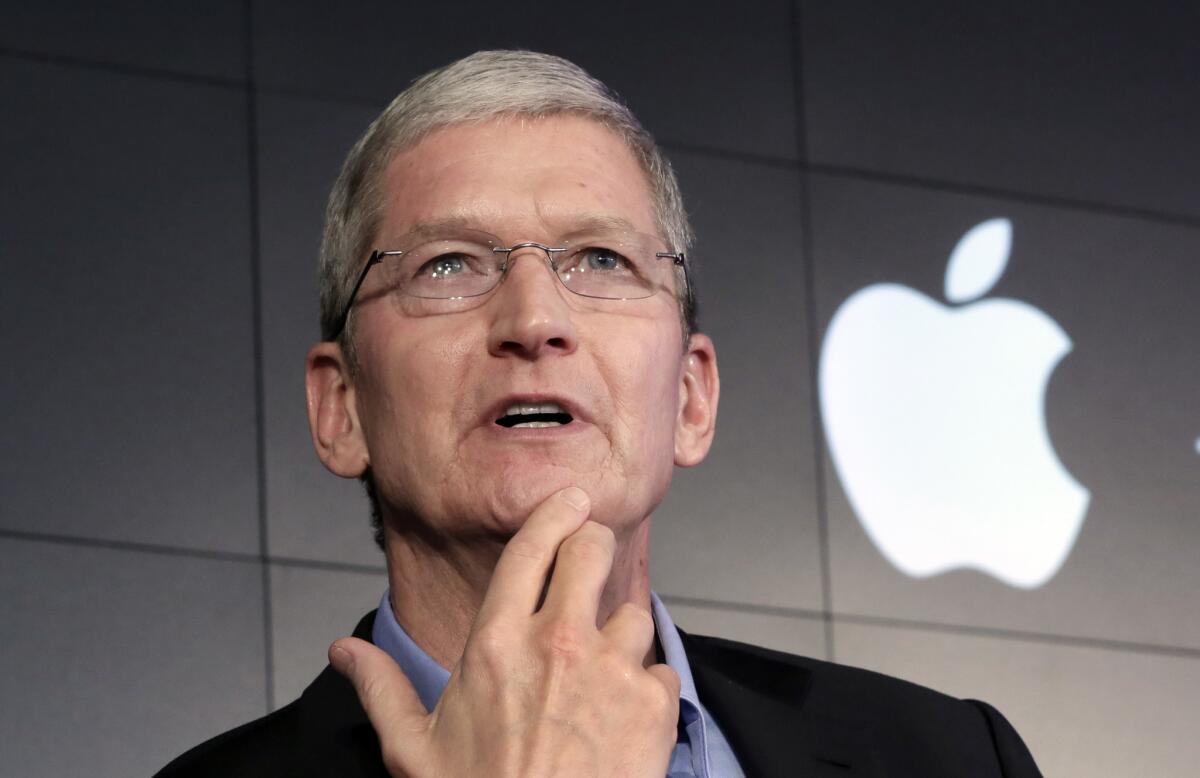Why Silicon Valley is betting big on India

Indian commuters use their smartphones following the introduction of a free wi-fi service in Mumbai’s central railway station. This year, the number of smartphone users in India is expected to exceed the size of the entire U.S. population.
- Share via
reporting from Bangalore, India — In a crowded convention hall, young entrepreneurs practically shouted their ideas: an online marketplace for yoga instructors, an app to share songs in 30-second snippets, a mobile lunch delivery service aimed at office workers.
For any veteran of the go-go era in Silicon Valley, the buzz at the recent Surge start-up conference in Bangalore, the cradle of India’s high-tech sector, was familiar and alluring. India’s digital start-up scene is booming as Internet use expands. By June, more Indians are expected to access the Internet on their cellphones — 371 million — than the entire population of the United States.
That leaves nearly 1 billion Indians not yet connected, and as China’s economy slows, U.S. tech companies and investors have turned increasingly to India. Venture capitalists have poured hundreds of millions of dollars into start-ups, and Silicon Valley giants such as Apple, Google and Facebook are courting Indians with their own initiatives.
“India has become, besides the U.S., the biggest opportunity still out there,” said Sanjit Singh Dang, investment director at Intel Capital, the venture capital arm of the Santa Clara-based computer chip manufacturer, which has invested in dozens of Indian start-ups.
Apple this month announced that it would open a 150-person office in the southern city of Hyderabad. Last year, while iPhone sales were flat worldwide, sales grew by 76% in India, prompting Chief Executive Timothy Cook to call the country an “incredibly exciting” market.
“The population in India is in some ways some of the best in the world,” Cook said during Apple’s shareholder conference Friday. “There’s a huge amount of young people moving up the ranks and the consumer will rise up there.”
The Cupertino company still commands just a 2% share of the Indian smartphone market, largely because new iPhones cost hundreds of dollars more than rival handsets. But Apple has wallpapered major cities with iPhone billboards, expanded distribution networks into smaller cities and applied for government permission to open its first retail stores in India.
The third-party retailers that currently sell Apple products have introduced payment plans known as EMIs, or equated monthly installments, to boost sales.

Indian Prime Minister Narendra Modi at an event to bolster start-ups in New Delhi in January.
That “has been a game changer,” said Kishor Prabhu, owner of a phone shop in suburban Mumbai. “Indians are a bit cost-conscious. With the introduction of EMI, the middle-class and upper middle-class have shifted toward the iPhone and it is no longer a phone only for the elites.”
Cook said one of the challenges in India is the “brittleness” of the wireless infrastructure itself, making it difficult — and sometimes impossible — to watch video on a smartphone, a basic function elsewhere.
Still, India’s demographics make corporate titans swoon. The median age is 27, nearly a full decade younger than in China. Only 40% of the mobile phones shipped in the last quarter of 2015 were smartphones, according to industry analyst Counterpoint Research, indicating the market still has huge growth potential.
To help find jobs for the 1 million Indians who enter the workforce every month, Indian Prime Minister Narendra Modi is trying to increase domestic manufacturing and has introduced incentives for tech companies to set up factories in India. He has met with Silicon Valley leaders including Mark Zuckerberg of Facebook, which sees India as its best chance to significantly expand its base of 1.55 billion users.
But Facebook faltered here this year when Zuckerberg’s pet project, a no-cost mobile app for emerging economies called “Free Basics” — a sort of Internet for beginners — was blocked by regulators who ruled that it discriminated against other Internet sites.
Google Inc. has tried to make its Android smartphones — by far India’s most popular — more suitable to the country’s slow Internet connections. The Mountain View search giant now allows Indian users to operate its Maps app offline and plans to introduce free wireless Internet service at hundreds of train stations.
Even though hundreds of millions of mostly rural Indians still lack Internet access, it is a golden age for the Indian digital consumer. Everything from doctor’s appointments to movie tickets can be booked online and a growing number of transactions are made using mobile wallets — all using apps designed by Indian companies.

Apple Chief Executive Tim Cook has called India an “incredibly exciting” market.
“The consumer is very much alive and kicking and actually consuming here, and that’s up to 1.3 billion people. The opportunity is huge,” said Radhika Aggarwal, cofounder of ShopClues.com, an e-commerce start-up that has been valued at more than $1.1 billion and targets middle-class consumers with unbranded clothing and other products.
The company was started by Indians who worked in Silicon Valley and returned as the Internet boom was beginning. Another company founded by Amazon.com alums, the e-commerce site Flipkart, has become the biggest Indian start-up to date, raising $6 billion in venture capital funding. Much of it came from U.S. investors — including Accel Partners of Palo Alto and Tiger Global Management of New York — writing big checks as the site nears a possible initial public offering.
The frenzy in 2015 created India’s first Internet bubble, and new investment has slowed down markedly in the first two months this year. Modi’s government is facing fresh calls to spur foreign investment when it unveils its annual budget in the coming week.
India’s freewheeling digital realm also seems at odds with what critics call a clampdown on free speech, after authorities this month arrested a university student on sedition charges, accusing the student of organizing an event where anti-India slogans were chanted.
“Investors have realized they went a little nuts,” said Pankaj Jain, a partner in 500 Startups, a Mountain View-based venture fund that invested in 24 early-stage Indian companies in 2015.
“A lot of companies are shutting down, scaling back, laying off people ... but that’s the normal course of business. It doesn’t change the fact that China is still very uncertain and the global economy is still not growing very well. India is probably the most stable and fastest growing economy in the world right now so that’s still going to attract a lot of people.”
The volatility has not daunted young Indian entrepreneurs. In the convention hall in Bangalore, four twentysomething engineers and designers talked up their venture, eFyDo, a portal linking consumers with doctors and yoga teachers.
Their research showed that online healthcare was a $280-billion market in India, with some 140 competing start-ups. But three years after its founding, the site has 2,000 visitors a month. All four had given up full-time jobs — though one was working shifts at KFC — and were looking for an investor.
“We think this is a really important idea,” said cofounder Deepak Rathi. “Our goal is to change healthcare in India.”
Special correspondent Parth M.N. contributed to this report from Mumbai, India. Staff writer Tracey Lien reported from Cupertino, Calif.
Follow @SBengali on Twitter for more news from South Asia
ALSO
Ku Klux Klan rally in Anaheim erupts in violence
Suspected street racer held in crash that killed 3 and shut down 5 Freeway
New Disneyland pricing: $5 less on slow days and $20 more when it’s busy
More to Read
Sign up for Essential California
The most important California stories and recommendations in your inbox every morning.
You may occasionally receive promotional content from the Los Angeles Times.











